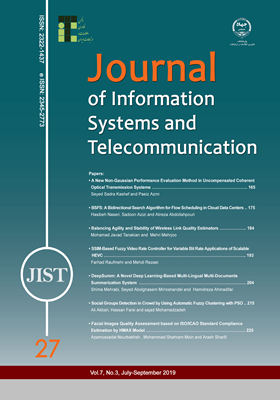-
-
List of Articles
-
Open Access Article
1 - A New Non-Gaussian Performance Evaluation Method in Uncompensated Coherent Optical Transmission SystemsUniversity of Birjand
Seyed Sadra Kashef paeez azmi -
Open Access Article
2 - BSFS: A Bidirectional Search Algorithm for Flow Scheduling in Cloud Data Centers
Hasibeh Naseri Sadoon Azizi Alireza Abdollahpouri -
Open Access Article
3 - Balancing Agility and Stability of Wireless Link Quality Estimators
MohammadJavad Tanakian Mehri Mehrjoo -
Open Access Article
4 - SSIM-Based Fuzzy Video Rate Controller for Variable Bit Rate Applications of Scalable HEVC
Farhad Raufmehr Mehdi Rezaei -
Open Access Article
5 - DeepSumm: A Novel Deep Learning-Based Multi-Lingual Multi-Documents Summarization System
Shima Mehrabi Seyed Abolghassem Mirroshandel Hamidreza Ahmadifar -
Open Access Article
6 - Social Groups Detection in Crowd by Using Automatic Fuzzy Clustering with PSO
Ali Akbari Hassan Farsi Sajad Mohammadzadeh -
Open Access Article
7 - Facial Images Quality Assessment based on ISO/ICAO Standard Compliance Estimation by HMAX Model
Azamossadat Nourbakhsh Mohammad-Shahram Moin Arash Sharifi
-
The rights to this website are owned by the Raimag Press Management System.
Copyright © 2017-2025







